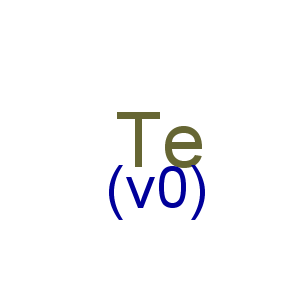Title: Tellurium
CAS Registry Number: 13494-80-9
Synonyms: Aurum paradoxum; metallum problematum
Literature References: Te; at. wt 127.60; at. no. 52; valence 2, 4, 6. Group VIA (16). Diatomic (Te2) in the vapor state. Eight stable isotopes: 120 (0.089%); 122 (2.46%); 123 (0.87%); 124 (4.61%); 125 (6.99%); 126 (18.71%); 128 (31.79%); 130 (34.48%); artificial radioactive isotopes: 114-119; 121; 127; 129; 131-134. Present in the earth's crust to the extent of 0.002 ppm. Discovered by von Reichenstein in 1782; named by Klaproth in 1798. Occurs as tellurides in combination with metals in the minerals tetradymite, altaite, coloradolite; found as the dioxide, tellurite; found also native, associated with silver and gold. Prepn: Kracek,
J. Am. Chem. Soc. 63, 1989 (1941); Fehér in
Handbook of Preparative Inorganic Chemistry vol. 1, G. Brauer, Ed. (Academic Press, New York, 2nd ed., 1963) pp 437-438. Prepn of spectrally pure Te for semiconductor devices: Weidel,
Z. Naturforsch. 9a, 697 (1954). Symposium on organic selenium and tellurium compds: Y. Okamoto, W. H. H. Gunther, Eds.,
Ann. N.Y. Acad. Sci. 192, 1-225 (1972).
Reviews: Stone, Caron in
Rare Metals Handbook, C. A. Hampel, Ed. (Reinhold, New York, 1954) pp 405-415; Bagnall in
Comprehensive Inorganic Chemistry vol. 2, J. C. Bailar, Jr.
et al., Eds. (Pergamon Press, Oxford, 1973) pp 935-1008; E. M. Elkin in
Kirk-Othmer Encyclopedia of Chemical Technology vol. 22 (Wiley-Interscience, New York, 3rd ed., 1983) pp 658-679.
Properties: Grayish-white, lustrous, brittle, crystalline solid, hexagonal, rhombohedral structure, or dark-gray to brown, amorphous powder with metal characteristics. d (cryst) 6.11-6.27. mp 449.8°. bp 989.9°. Electrical resistivity (19.6°): 200,000 m-ohms-cm. Latent heat of fusion: 4.27 kcal/mole. Linear coefficient of thermal expansion: 16.8′10-6/°C. Modulus of elasticity: 6,000,000 psi. Specific heat (solid): 0.047 cal/g/°C. Magnetic susceptibility (18°): -0.31′10-6 cgs. Hardness (Mohs): 2.3. Thermal conductivity: 0.014 at 20°. Burns in air with a greenish-blue flame, forming the dioxide. Insol in water, in benzene, in carbon disulfide. Not attacked by hydrochloric acid; reacts with nitric acid; with concd or fuming sulfuric acids, forming a red soln; in presence of air dissolves in potassium hydroxide with formation of a deep-red soln. Combines with the halogens; does not react with sulfur or selenium.
Melting point: mp 449.8°
Boiling point: bp 989.9°
Density: d (cryst) 6.11-6.27
CAUTION: Potential symptoms of overexposure are garlic odor on breath and sweat; dry mouth, metal taste; somnolence; anorexia, nausea and no sweating; dermatitis.
See NIOSH Pocket Guide to Chemical Hazards (DHHS/NIOSH 97-140, 1997) p 294.
Use: As coloring agent in chinaware, porcelains, enamels, glass; reagent in producing black finish on silverware; in manuf special alloys of marked electrical resistance; in semiconductor research.

